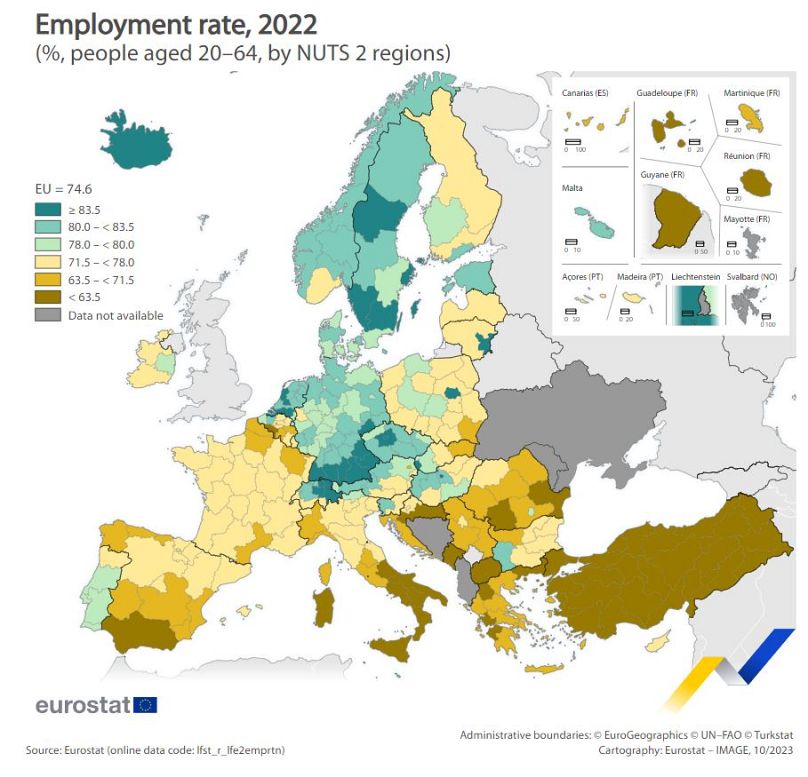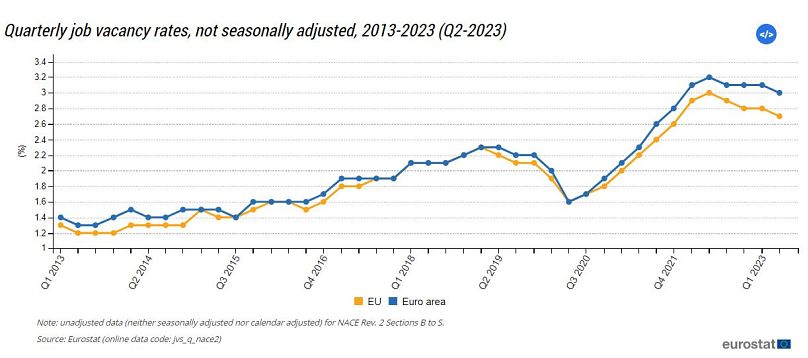The employment rate in the EU reached a historic high of 74.6 % in 2022, according to new data from Eurostat. But which regions are faring better than others?
When looking at European employment rates on a map, it’s easy to see the division between northern and southern states.
Eurostat, the European Commission’s statistics office, found that after dividing countries into 242 basic regions (NUTS 2), two fifths of areas had an employment rate equal to or above 78%.
These areas were predominantly concentrated in Czechia, Denmark, Germany, Estonia, Malta, the Netherlands and Sweden.
In the Finnish archipelago of Åland, Eurostat noted the highest employment rate of 89.7%, and the second highest rate was recorded in the Polish capital region of Warsaw, where employment was at 85.4%.
The Dutch region of Utrecht and the Swedish capital region of Stockholm came in behind these two areas, both with an employment rate of 85.1%.
On the other end of the scale, in three regions in southern Italy, Eurostat found that less than half of the population was employed in 2022.
These areas were Sicily (46.2%), Calabria (47.0%) and Campania (47.3%).
In some parts of Turkey, the employment rate fell even lower than in Italy, collectively recorded at 32.8% in the cities of Mardin, Batman, Şırnak, and Siirt.
How much have employment rates shifted?
Out of the regions studied, Eurostat found that 9 in 10 witnessed an increase in employment rates between 2021 and 2022.
The top five areas with the highest rate growth include four Greek regions: Epirus (up 7.7 percentage points), Southern Aegean (+5.8), Crete (+5.7) and Central Greece (+5.4).
High growth was also seen in the Spanish Canary Islands, with an increase of 5.5 percentage points.
That said, a rising employment rate wasn’t noted across the board, as a minority of states saw a decline in the number of their citizens working.
The Polish region of Opole Voivodeship witnessed a fall of 1.5 percentage points, followed by the Spanish region of Melilla (-1.3), the German region of Lower Franconia (-1.2), and the French regions of Limousin (-1.0), Brittany, and Guadeloupe (both -0.9).
Unemployment falls, job vacancies remain high
Alongside a rise in employment, the latest figures from August 2023 also show that unemployment has been decreasing in the EU.
The two figures are clearly linked but can also be affected by the number of people who fall into neither category, such as those who are students or carers.
The EU unemployment rate was 5.9% in August 2023, down from 6.0% in July 2023, and from 6.1% in August 2022.
Yet despite this promising trend, William Mitchell, Professor of Economics at the University of Newcastle in Australia, told Euronews that “unfilled vacancies are now signalling an impending weakness”.
Following the COVID-19 pandemic, which dramatically reshaped the job market, most EU member states experienced a sharp rise in job vacancies.
In mid 2022, vacancies in the EU began to slowly decline again, but they are still far higher than pre-pandemic levels.
This suggests there are mismatches between worker’s skills and employer’s requirements, which leads to a risk of decreased productivity and competitiveness.
In order to tackle this, the EU has pledged to better anticipate shifts in the job market, facilitate professional mobility, and improve the adaptability of workers.
Professor Mitchell also pointed to European Central Bank (ECB)'s string of interest rate rises.
He said that strong employment figures suggest “the monetary policy changes have not had the impact that many economists believed”, adding that “the real economy is not very sensitive to interest rate changes within the range we have observed”.
Some feared that the rate rises could cause greater unemployment by provoking a reduction in consumer spending and investment, a scenario that has so far been avoided.
The ECB is due to announce its next monetary policy decision on Thursday, with analysts expecting the bank to end its long streak of interest rate hikes.





